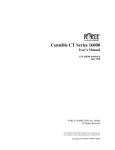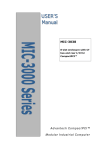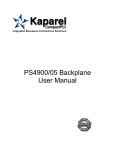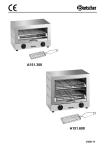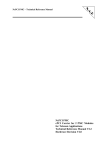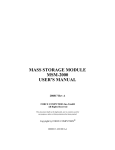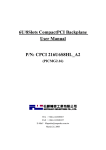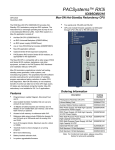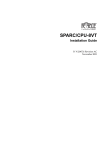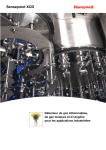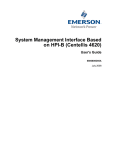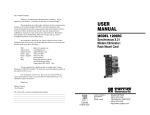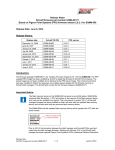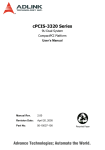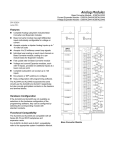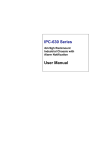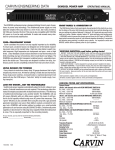Download Emerson / Motorola / Force CT Series 16000 H/S User Manual
Transcript
Centellis CT Series 16000 H/S User’s Manual P/N 211264 Edition B April 1999 FORCE COMPUTERS Inc./GmbH All Rights Reserved This document shall not be duplicated, nor its contents used for any purpose, unless express permission has been granted. Copyright by FORCE COMPUTERS World Wide Web: www.forcecomputers.com Includes 24-hour access to SMART, a SolutionsPLUS customer support program that provides current technical and service information. Headquarters The Americas Europe Asia FORCE COMPUTERS Inc. 2001 Logic Drive San Jose, CA 95124-3468 U.S.A. FORCE COMPUTERS GmbH Prof.-Messerschmitt-Str. 1 D-85579 Neubiberg/München Germany Tel.: +1 (408) 369-6000 Fax: +1 (408) 371-3382 Email [email protected] Tel.: +49 (89) 608 14-0 Fax: +49 (89) 609 77 93 Email [email protected] FORCE COMPUTERS Japan KK Miyakeya Building 4F 1-9-12 Hamamatsucho Minato-ku, Tokyo 105 Japan Tel.: +81 (03) 3437 3948 Fax: +81 (03) 3437 3968 Email [email protected] NOTE The information in this document has been carefully checked and is believed to be entirely reliable. FORCE COMPUTERS makes no warranty of any kind with regard to the material in this document, and assumes no responsibility for any errors which may appear in this document. F ORCE COMPUTERS reserves the right to make changes without notice to this, or any of its products, to improve reliability, performance, or design. F ORCE COMPUTERS assumes no responsibility for the use of any circuitry other than circuitry which is part of a product of F ORCE COMPUTERS Inc./GmbH. F ORCE COMPUTERS does not convey to the purchaser of the product described herein any license under the patent rights of F ORCE COMPUTERS Inc./GmbH nor the rights of others. All product names as mentioned herein are the trademarks or registered trademarks of their respective companies. Table of Contents About This Manual . . . . . . . . . . . . . . . . . . . . . . . . . . . . . . . . . . . . . . . . . . . . . . . . . . . . . . . . . . . . . . . . vii Chapter 1 Introduction . . . . . . . . . . . . . . . . . . . . . . . . . . . . . . . . . . . . . . . . . . .1 1.1 Product Overview . . . . . . . . . . . . . . . . . . . . . . . . . . . . . . . . . . . . . . . . . . . . . . . . . . . 1 1.2 Chassis Description . . . . . . . . . . . . . . . . . . . . . . . . . . . . . . . . . . . . . . . . . . . . . . . . . . 1 1.3 System Features . . . . . . . . . . . . . . . . . . . . . . . . . . . . . . . . . . . . . . . . . . . . . . . . . . . . 3 1.4 System Applications . . . . . . . . . . . . . . . . . . . . . . . . . . . . . . . . . . . . . . . . . . . . . . . . . 4 Chapter 2 System Installation. . . . . . . . . . . . . . . . . . . . . . . . . . . . . . . . . . . . . .5 2.1 Site Preparation . . . . . . . . . . . . . . . . . . . . . . . . . . . . . . . . . . . . . . . . . . . . . . . . . . . . . 5 2.2 Hardware Unpacking . . . . . . . . . . . . . . . . . . . . . . . . . . . . . . . . . . . . . . . . . . . . . . . . 6 2.3 Warnings and Safety Information . . . . . . . . . . . . . . . . . . . . . . . . . . . . . . . . . . . . . . . 7 2.4 Hardware Installation . . . . . . . . . . . . . . . . . . . . . . . . . . . . . . . . . . . . . . . . . . . . . . . . 7 2.4.1 CPU I/O Card Installation. . . . . . . . . . . . . . . . . . . . . . . . . . . . . . . . . . . . . . . 8 2.4.2 CPCI Rear Card Installation . . . . . . . . . . . . . . . . . . . . . . . . . . . . . . . . . . . . . 8 2.4.3 Drive Installation . . . . . . . . . . . . . . . . . . . . . . . . . . . . . . . . . . . . . . . . . . . . . 8 2.5 Software Installation . . . . . . . . . . . . . . . . . . . . . . . . . . . . . . . . . . . . . . . . . . . . . . . . . 9 2.6 Power-up Procedures . . . . . . . . . . . . . . . . . . . . . . . . . . . . . . . . . . . . . . . . . . . . . . . . 9 2.6.1 Connecting Chassis Peripherals . . . . . . . . . . . . . . . . . . . . . . . . . . . . . . . . . . 9 2.6.2 Powering Up . . . . . . . . . . . . . . . . . . . . . . . . . . . . . . . . . . . . . . . . . . . . . . . . 10 Chapter 3 System Description . . . . . . . . . . . . . . . . . . . . . . . . . . . . . . . . . . . .11 3.1 Hardware Components . . . . . . . . . . . . . . . . . . . . . . . . . . . . . . . . . . . . . . . . . . . . . . 11 3.1.1 Chassis and Card Cage . . . . . . . . . . . . . . . . . . . . . . . . . . . . . . . . . . . . . . . . 11 3.1.2 CompactPCI Backplane . . . . . . . . . . . . . . . . . . . . . . . . . . . . . . . . . . . . . . . 13 3.1.3 Integrated Media Carrier. . . . . . . . . . . . . . . . . . . . . . . . . . . . . . . . . . . . . . . 15 3.1.4 Fan Tray . . . . . . . . . . . . . . . . . . . . . . . . . . . . . . . . . . . . . . . . . . . . . . . . . . . 15 3.1.5 Power Supplies . . . . . . . . . . . . . . . . . . . . . . . . . . . . . . . . . . . . . . . . . . . . . . 15 3.2 Chassis Backplane Layout . . . . . . . . . . . . . . . . . . . . . . . . . . . . . . . . . . . . . . . . . . . 17 3.3 Connectors and Pinouts. . . . . . . . . . . . . . . . . . . . . . . . . . . . . . . . . . . . . . . . . . . . . . 17 3.4 AC Power Connector . . . . . . . . . . . . . . . . . . . . . . . . . . . . . . . . . . . . . . . . . . . . . . . 17 3.5 CompactPCI Connector Pin Assignments . . . . . . . . . . . . . . . . . . . . . . . . . . . . . . . 18 3.5.1 J1/J2 Backplane CompactPCI Connector . . . . . . . . . . . . . . . . . . . . . . . . . . 18 3.5.2 J3: Backplane I/O Connector . . . . . . . . . . . . . . . . . . . . . . . . . . . . . . . . . . . 18 3.5.3 J4 Backplane I/O Connector . . . . . . . . . . . . . . . . . . . . . . . . . . . . . . . . . . . . 18 3.5.4 J5 Backplane I/O Connector. . . . . . . . . . . . . . . . . . . . . . . . . . . . . . . . . . . . 20 Chapter 4 Requirements and Certifications . . . . . . . . . . . . . . . . . . . . . . . . . .21 4.1 Safety and Emissions Certification . . . . . . . . . . . . . . . . . . . . . . . . . . . . . . . . . . . . . 21 iii Table of Contents 4.2 Regulatory Requirements . . . . . . . . . . . . . . . . . . . . . . . . . . . . . . . . . . . . . . . . . . . . 22 4.3 Mechanical Specifications . . . . . . . . . . . . . . . . . . . . . . . . . . . . . . . . . . . . . . . . . . . 22 Appendix A Product Error Report iv List of Figures Figure Figure Figure Figure Figure Figure Figure 1: 2: 3: 4: 5: 6: 7: Centellis Assembly Drawing, Front View . . . . . . . . . . . . . . . . . . . . . . . . . . . . . . . . . 2 Centellis Assembly Drawing, Rear View . . . . . . . . . . . . . . . . . . . . . . . . . . . . . . . . . 2 Power Controls (Chassis Rear View, Lower Left) . . . . . . . . . . . . . . . . . . . . . . . . . . 6 Centellis CT 16000, Front View . . . . . . . . . . . . . . . . . . . . . . . . . . . . . . . . . . . . . . . 12 Centellis Backplane Layout Drawing . . . . . . . . . . . . . . . . . . . . . . . . . . . . . . . . . . . 13 Centellis CT 16000, Rear View . . . . . . . . . . . . . . . . . . . . . . . . . . . . . . . . . . . . . . . . 14 AC Power Connector . . . . . . . . . . . . . . . . . . . . . . . . . . . . . . . . . . . . . . . . . . . . . . . . 17 List of Tables Table 1. Table 2. Table 3. Table 4. Table 5. Table 6. Table 7. Environmental Conditions . . . . . . . . . . . . . . . . . . . . . . . . . . . . . . . . . . . . . . . . . . . . . . 5 CPCI Backplane Geographical Addressing . . . . . . . . . . . . . . . . . . . . . . . . . . . . . . . . 15 Power Supplies Specifications. . . . . . . . . . . . . . . . . . . . . . . . . . . . . . . . . . . . . . . . . . 16 AC Power Connector . . . . . . . . . . . . . . . . . . . . . . . . . . . . . . . . . . . . . . . . . . . . . . . . . 17 J4 Pin Assignments . . . . . . . . . . . . . . . . . . . . . . . . . . . . . . . . . . . . . . . . . . . . . . . . . . 19 J4 Pin Assignments Key . . . . . . . . . . . . . . . . . . . . . . . . . . . . . . . . . . . . . . . . . . . . . . 19 Physical Specifications . . . . . . . . . . . . . . . . . . . . . . . . . . . . . . . . . . . . . . . . . . . . . . . 22 v vi Centellis CT Series 16000 H/S User’s Manual Preface About This Manual This preface provides an overview of the content and format features of the Centellis CT-16000 H/S User’s Manual. Topics covered in this preface include the manual structure, terminology, format conventions, and reference documents. Audience This user’s manual is intended for administrators and users of the Centellis CT Series 16000 H/S system family. It is assumed that the reader of this manual has a working understanding of Peripheral Component Interconnect (PCI), Compact Peripheral Component Interconnect (CPCI), and telephony communications. Manual Overview This manual provides a comprehensive guide to the Centellis CT Series 16000 H/S system. IMPORTANT Examine the manual’s “Table of Contents” to see how this document is structured. This will aid you in the future when looking for specific information. This manual includes: • an introductory overview of the Centellis CT Series 16000 H/S (Section 1, “Introduction”) • installation and setup instructions for the Centellis CT Series 16000 H/S (Section 2, “Installation”) • descriptions of the Centellis CT Series 16000 H/S and its individual hardware and software components (Section 3, “System Description”) • test, certification, and conformance specifications (Section 4, “Requirements and Certifications”) • a copy of the Force Computers Product Error Report (Appendix A, “Product Error Report”). Terminology BIOS - Basic Input Output System CPCI - Compact Peripheral Component Interconnect: A mechanical form factor of PCI, CPCI is electrically compatible with PCI. EIDE - Enhanced Integrated Drive Electronics ESD - Electrostatic Sensitive Device H/S - Hot Swap PCI - Peripheral Component Interconnect: A specification defining a common interconnect between logic components PICMG - PCI Industrial Manufacturers Group RFI - Radio Frequency Interference SBC - Single Board Computer SCA - Single Connector Attachment 20001172 420 000 AB vii Preface Centellis CT Series 16000 H/S User’s Manual Reference Documents Supporting documentation for this manual, the Centellis CT-16000 H/S system, and the system components is available from the following list of sources. Refer to the list below or to the respective sections of the Centellis CT-16000 H/S User’s Manual to determine the source for specific documents required. • PICMG 2.0 R2.1 CompactPCI Specification (September 2, 1997) • PICMG 2.1 R1.0 CompactPCI Hot Swap Specification (August 3, 1998) • PICMG 2.5 R1.0 CompactPCI Computer Telephony Specification (April 3, 1998) Special Message Icons and Notes There are three levels of iconicized notes used in this manual. These notes are described below via typical layout examples. Always read and follow the safety notes whenever they appear in the manual. Failure to follow these instructions can result in personal injury or equipment damage. WARNING Danger: Personal injury or equipment damage possible. CAUTION Warning: No danger to people, but equipment damage or loss of data possible. ! IMPORTANT Special Message: Important product features, instructions, and user tips and information. Publication History viii Revision Date Writer Description AA April 1999 G. A. Osika First Release AB April 1999 G. A. Osika Second Release (per I10720) 20001172 420 000 AB Centellis CT Series 16000 H/S User’s Manual Introduction Chapter 1 Introduction This chapter provides introductory information on the purpose, features, and functions of the Centellis CT Series 16000 H/S system. (The system will also be referred to in this document as the 16000 H/S or the 16000.) 1.1 Product Overview The Centellis CT Series 16000 H/S (hot swappable) is a CompactPCI (CPCI) rack-mounted system chassis for CompactPCI environments. The chassis’rugged construction and integral mounting points provide the high quality and versatility necessary for peak product performance. The 16000 chassis supports 14 standard 6U CPCI slots in numerous user-implemented I/O configurations. Three additional 6U CPCI slots are reserved for a main processor board. 1.2 Chassis Description The Centellis CT Series 16000 H/S is an aluminum chassis designed primarily for mounting in a standard 19- or 23-inch equipment rack. The chassis encases a slotted card cage that houses a 16slot CPCI basic hot swap backplane. The CompactPCI backplane has 14 open 6U slots after the CPU board is installed. The chassis contains an integrated media carrier with space for one frontaccessible 5-1/4" half-height disk drive and one internal 3-1/2" half-height disk drive. Two 300 watt AC power supplies with individual on/off switches and 110VAC/230VAC voltage switches provide system power. System cooling is handled by a three-fan tray module. The chassis has EMI/RFI-tight front and rear covers, and 80mm rear transition boards. Convertible mounting ears are provided for rack mounting. The mounting ears can be attached either flush to the front of the chassis or at a chassis midpoint recess. Figure 1 shows the internal component modules located at the front of the Centellis CT Series 16000 H/S chassis; Figure 2 shows the modules located at the rear of the chassis. 20001172 420 000 AB Page 1 Introduction Centellis CT Series 16000 H/S User’s Manual 6U Expansion Slots 6U Expansion Slots Figure 1: Centellis Assembly Drawing, Front View b l a 80 n 80 mm k mm I/O I/O BP BP 80mm I/O Expansion 300W Power Supply 80mm I/O Expansion 300W Power Supply Figure 2: Centellis Assembly Drawing, Rear View Page 2 20001172 420 000 AB Centellis CT Series 16000 H/S User’s Manual 1.3 Introduction System Features CompactPCI and the H.110 CT bus, the primary technologies of the Centellis CT Series 16000 H/S, provide high-speed performance, manageability, and flexibility for growing telephony applications. Key hardware and software features include: • 16-slot CompactPCI Backplane - Hot swap ready - Secondary H.110 CT bus - 14 6U I/O expansion slots - Passive (non-active) components - Integrated alarms on power backplane • I/O Connectivity - 80 mm rear I/O transition boards - Configurable front or rear CPU I/O connectivity • Power Supply - Two rear-serviceable 300W modules - Load sharing (with system power up to 300W) - Hot swappable (with system power less than or equal to 300W) - 110/220 VAC voltage user-selectable - Switched, fused, and filtered AC system input • Chassis - Aluminum chassis - Size: 17" W x 17" D 15.75(9U) H (432 mm x 432 mm x 400 mm) - 19" or 23" equipment rack mounting via chassis mounting ears - Front-flush or midpoint recessed rack mounting • Integrated Media Carrier - One front-accessible 5.25" drive bay - One internal 3.5" drive bay • Fan Tray Module - Three 12VDC brushless fans - 110 CFM (cubic feet per minute)/fan (330 CFM total) air draw - Front-to-back cooling airflow - Front-serviceable - No monitoring or sensing 20001172 420 000 AB Page 3 Introduction 1.4 Centellis CT Series 16000 H/S User’s Manual System Applications The Centellis CT Series 16000 H/S system chassis was designed as a CompactPCI platform for a variety of embedded applications. Users can install up to 14 6U CompactPCI boards into the chassis. System chassis configurations can include 3.5" hard disk drives and a CD-ROM drive. Applications for the Centellis CT Series 16000 H/S include: • Telephony applications, including voice and FAX processing • WLL applications for SS7 execution • Firewall applications for data filtering • Other applications with additional intelligent I/O or real-time processing boards Page 4 20001172 420 000 AB Centellis CT Series 16000 H/S User’s Manual Installation Chapter 2 System Installation This chapter provides CT 16000 H/S installation information on site preparation, chassis unpacking, specific hardware and software installation notes, important warnings and safety notes, and power-up procedures. 2.1 Site Preparation Several factors must be considered when selecting and preparing an installation site for the CT 16000 H/S system. These factors include: Environment Table 1 lists the environmental conditions and requirements for the Centellis CT 16000 H/S. These requirements are for systems configured with the maximum power load and at the minimum worst case input voltages. Table 1: Environmental Conditions Requirement Condition Rating Operating (maximum load) Non-operating 5°C to 40°C * -25°C to 65°C ** Operating Non-operating 10% to 95% (at 20°C to 40°C) 5% to 95% (at 20°C to 55°C) Operating 5g Storage/Transit. Shock: Operating Non-operating 10G (no installed drives) 40G (Storage/Transit) Altitude: Operating Non-operating -300 to 3,000m -300 to 12,000m Temperature: Relative Humidity: (except media carrier drives) Vibration: * Temperature specifications are valid only if sufficient airspace is allowed around the chassis. ** Non-operating temperature for media carrier drives are -40°C to 70°C. Power The Centellis CT Series 16000 H/S has one AC input power connector and an on/off power switch located at the lower left rear of the chassis. The locations of these power controls are called out in Figure 4. The symbol at the top of the green switch indicates the on position; the O symbol on the bottom half of the switch indicates the off position. Two user-replaceable 7A fuses are provided to the left of the power switch. The unit’s power cord is detachable. Input voltage for the two AC power supplies is selectable via external slide switches. 20001172 420 000 AB Page 5 Installation Centellis CT Series 16000 H/S User’s Manual On/Off Switch Fuses Power Connector Figure 3: Power Controls (Chassis Rear View, Lower Left) IMPORTANT The socket outlet that the system is connected to must be installed near the equipment and readily accessible. Ventilation and Airflow Three throughput fans in the Centellis CT Series 16000 H/S, and a fan on each power supply, provide optimal chassis airflow. Adequate space must always exist around the fans and the air inlets and outlets for successful airflow. Allow at least 3-1/2" at the front and back of the chassis, and do not cover the side vents. Equipment Rack Position the equipment rack that the CT 16000 H/S will be mounted in on a flat, stable floor surface and near a functional power outlet or socket. 2.2 Hardware Unpacking When receiving the CT 16000 H/S, check the attached packing slip to verify that the equipment that was ordered was correctly shipped and received in full. Contact Force Computers if any discrepancy exists among the original purchase order, the packing slip, and the received equipment. Visually inspect the product for any physical damage. The product was shipped from Force Computers manufacturing new and in working condition; any product damage must be immediately reported to the shipping agent. Save the shipping carton and packing materials in case the system must be reshipped in the future. Page 6 20001172 420 000 AB Centellis CT Series 16000 H/S User’s Manual 2.3 Installation Warnings and Safety Information WARNING This section contains several important check points which must be observed before the chassis is powered on. In addition, warnings and safety statements are included throughout this manual for specific equipment and operating situations. • Follow all warnings and instructions marked on the equipment. • This equipment generates, uses and can radiate radio frequency energy. If not installed correctly and used in accordance with the instruction manual, it may cause interference to radio communications. It has been tested and found to comply with the limits of a Class A computing device pursuant to EN55022 Class A, FCC Rules, Part 15, Subpart B. If operating the system when it is not in compliance with these instructions and rules, or in the case of interference from radio stations, the user is required to take whatever measures (EMI measurements) necessary to correct the disturbances at the user’s expense. • Use a ferrite bead on the following cables: parallel, serial, Ethernet, mouse, and keyboard. Wind the cable around the ferrite bead one full turn. • Connections between peripherals of the computer equipment must be made with low-voltage, shielded computer data cables. • FORCE COMPUTERS, Inc. is not responsible for regulatory compliance or malfunction of any user-modified product. CAUTION ESD PRECAUTIONS - Static Electricity Destroys Products ! The chassis contains static-sensitive devices. Good static control procedures must be used when installing, removing, and handling all components. Use an antistatic wrist strap at all times. Never touch the board components with any conductive objects. 2.4 Hardware Installation WARNING When servicing or mounting the CT 16000 in an equipment rack, take special precautions to prevent bodily injury and to ensure the rack’s physical stability. The following guidelines are provided to ensure safety: • If stabilizing devices are available for the rack, install the stabilizers before either mounting or servicing any equipment in the rack. • If no other equipment is mounted in the rack, mount the CT 16000 chassis at the bottom of the rack. If a rack is partially filled with other equipment, mount the chassis in the lowest available open space in the rack. 20001172 420 000 AB Page 7 Installation Centellis CT Series 16000 H/S User’s Manual • Always load the equipment rack from bottom to top. The uneven mounting of multiple chassis could create an unsteady, top-heavy rack which could easily topple over. Mount the heaviest components at the bottom of the rack. The Centellis CT 16000 H/S system is designed for mounting in either a 19-inch or 23-inch standard equipment rack. An L-bracket for rack mounting is preinstalled on each side of the chassis. The chassis has two mounting hole positions: one near the front side of the chassis, and one in the middle. 2.4.1 CPU I/O Card Installation Ensure that the CPU card is properly installed between the two seven-slot I/O segments. The board contains special ejectors (the handles). To guarantee proper installation, the board must be plugged in, the handles on the front panel firmly locked, and all screws must be tightened to the card cage. 2.4.2 CPCI Rear Card Installation Take special care when installing or removing any card from any card slot at the rear of the Centellis CT chassis. • • When installing a card into a card slot, slide the card in slowly and evenly (i.e., the bottom of the card is not pushed in faster than the top of the card). Assure that the backplane pins insert into the connector BEFORE pushing in firmly. The lower ejector handle must remain in its finished position while the upper ejector handle seats the upper connector properly at the top. Avoid pushing the card into the slot with excessive force: the connector pins may be bent if unequal pressure is applied. When removing a card from a card slot, pull the card out with a steady, equal effort at both the top and the bottom of the card’s cover panel. IMPORTANT Keep the card positioned straight and perpendicular to the card guides at all times during card installation or removal. 2.4.3 Drive Installation The chassis contains an integrated media carrier that holds one external (front-accessible) 5.25" half-height disk drive and one internal 3.5" disk drive. The 5.25" disk drive bay normally holds a CD-ROM drive (SCSI or IDE), but it can be used for a tape backup device. The 3.5" disk drive bay accommodates either a SCSI or IDE 3.5" hard disk drive. To install either a 5.25" CD-ROM or a 3.5" hard disk drive in the media carrier: 1. Unscrew the two thumb screws on the face plate of the media carrier, and pull the tray out of the chassis. 2. Install the CD-ROM or the hard disk drive to the media carrier. • For hard disk drives, mount the drive onto the HDD mounting bracket with a 6/32" x 1/4" Phillips pan head screw, a #6 split lock washer, and a #6 flat washer at each of the four positions. Do not mount this assembly to the media carrier yet; OR Page 8 20001172 420 000 AB Centellis CT Series 16000 H/S User’s Manual 3. 4. 5. 6. 7. 2.5 Installation • For CD-ROM drives, align the four mounting screw holes on the media carrier and the CD-ROM. Attach the drive to the media carrier with four 3cm x 6cm pan head screws, four M3 split lock washers, and four M3 flat washers. Attach one end of the flat ribbon cable (the end with two connectors close to each other) and one end of the power cable to the CD-ROM or hard disk drive. For a hard disk drive, attach the completed drive/HDD mounting bracket assemblage to the media carrier with four 6/32" x 1/4' flat head screws. Reinsert the media carrier with the attached drive(s) back into the chassis. Remove the left rear panel, and attach the other end of the flat ribbon cable to the I/O boards. Route the cables together as directly as possible to avoid cable damage and to save space for other cables and boards. CAUTION: Pin 1 of the flat ribbon cable (red stripe) MUST match with Pin 1 of the connector. Retighten the two thumb screws on the carrier faceplate to secure the carrier to the chassis. Software Installation System software for the Centellis CT 16000 H/S consists of BIOS routines, an operating system, and software device drivers. All system software is pre-installed at Force Computers. If installation, removal, or reinstallation instructions are absolutely necessary, contact Force Computers Customer Engineering and Services department or the appropriate software manufacturer. 2.6 Power-up Procedures Note the following CAUTION statements before powering up the CT 16000 H/S system chassis. CAUTION ! To allow for sufficient cooling of the card cage slots, do not exceed an 18 watt limit per CompactPCI slot. As to the power consumption of the components used, see the respective technical specifications. Furthermore, make sure that the individual output currents of the separate sources are not exceeded. CAUTION ! Do not attach like devices to both the front CPU panel and the rear chassis panel as damage to components may result. The 16000 has CPU board connectors at the front of the chassis and I/O connectors at the back. 2.6.1 Connecting Chassis Peripherals Peripheral components can be connected to the Centellis CT chassis at the CPU board in the front of the chassis, or at the I/O transitional board at the back of the chassis. Parallel and serial cables for these peripherals must have ferrite beads. 20001172 420 000 AB Page 9 Installation 2.6.2 Centellis CT Series 16000 H/S User’s Manual Powering Up 1. At the bottom left rear of the Centellis CT chassis, remove the power input label from the AC input power connector. 2. Verify that the input voltage setting is set to the proper voltage (110VAC or 220VAC). 3. Connect the power cable to the AC connector. 4. Push the black power switch on each power supply to the on ( | ) position. 5. Push the chassis’ green power switch to the on ( | ) position. After a few seconds, a message will appear on the connected monitor. 6. Verify that the fans are running and that the LEDs on the power supplies and boards, if available, indicate the run status. 7. To boot the installed operating system, see the operating system’s user’s manual. Page 10 20001172 420 000 AB Centellis CT Series 16000 H/S User’s Manual System Description Chapter 3 System Description This chapter describes the Centellis CT Series 16000 H/S system. Detail is provided on the system’s modules and components, connections, controls and indicators, software, and backplane connectors. 3.1 Hardware Components The Centellis CT Series 16000 H/S is a hot swappable CompactPCI-based system chassis designed for CompactPCI in a computer telephony environment. The 16000 H/S’s modularity ensures easy operation, flexibility, and easy rack mounting. All module interconnections in the system are made via standard connectors. The Centellis CT 16000 H/S system consists of the following modular components: • Chassis and internal card cage • CPCI backplane • Media carrier • Fan tray • Power supplies (two) • Single board computer • Peripheral equipment 3.1.1 Chassis and Card Cage The Centellis CT 16000 H/S chassis is an aluminum enclosure that houses a 16-slot CPCI card cage. The chassis is shipped with two installed 7-slot 6U front panels that cover the 14 user I/O expansion slots; an installed CPU separates the panels into the two 7-slot segments. CompactPCI boards can be installed in or removed from the chassis after one or both of the 7-slot 6U front panels are removed. If a seven-slot segment is not fully occupied by CPCI boards, a single-slot 6U blank panel (with EMI gasket) must be installed in each unoccupied slot. All slots of the chassis must be either occupied by a board or closed off with a covering panel to maintain the EMI integrity of the system. An installed media carrier panel for a 5.25" drive bay fills the far right end of the chassis. A pluggable fan tray panel with air intake grillwork is attached to the bottom of the chassis via thumb screws. Figure 4 shows the front of the Centellis chassis. 20001172 420 000 AB Page 11 System Description Centellis CT Series 16000 H/S User’s Manual 3-slot processor board Two 7-slot 6U I/O segments (cover panels in place) 5.25” disk drive 19” or 23” mounting L-bracket Field replaceable fan tray with air intake Figure 4: Centellis CT 16000, Front View Page 12 20001172 420 000 AB Centellis CT Series 16000 H/S User’s Manual CompactPCI Backplane The Centellis CT Series 16000 H/S chassis supports a 6U CompactPCI 16-slot backplane. A double-slotted processor board subdivides the backplane into two independent 7-slot I/O segments. (Although 17 slots are physically available, a third processor slot is an inactive "dummy" slot.) Figure 5 is a basic CPCI backplane layout drawing. Figure 6 shows the rear of the 16000 chassis: a blank panel covers one seven-slot segment, while the processor slots and second 7-slot segment are uncovered and ready for board installation. The backplane is hot swappable, passive (contains no active components), and provides nonshared clock signals. Table 2 lists the geographical slot address of each of the labeled physical slots. J5 J4 3-slot CPU board set 6U Expansion Slot 6U Expansion Slot 6U Expansion Slot 6U Expansion Slot 6U Expansion Slot 6U Expansion Slot 6U Expansion Slot 6U Expansion Slot 6U Expansion Slot 6U Expansion Slot 6U Expansion Slot 6U Expansion Slot 6U Expansion Slot J3 6U Expansion Slot 3.1.2 System Description J2 J1 Figure 5: Centellis Backplane Layout Drawing 20001172 420 000 AB Page 13 System Description Centellis CT Series 16000 H/S User’s Manual Top rear air exhaust 7-slot cover panel 16-slot Compact PCI backplane AC switch Power supply unit 80mm transition module Figure 6: Centellis CT 16000, Rear View Page 14 20001172 420 000 AB Centellis CT Series 16000 H/S User’s Manual System Description Table 2: CPCI Backplane Geographical Addressing 3.1.3 Geographical Address Physical Slot 1 A1 2 A2 3 A3 4 A4 5 A5 6 A6 7 A7 8 A8 9 - 10 B9 11 B10 12 B11 13 B12 14 B13 15 B14 16 B15 17 B16 Label Integrated Media Carrier The chassis contains an integrated media carrier that holds one 3.5" disk drive bay (for SCSI or EIDE hard disk drives) and one front-accessible 5.25" CD-ROM disk drive bay. 3.1.4 Fan Tray There are three brushless DC fans for chassis cooling in the bottom of the 16000; an additional cooling fan is a part of each power supply. 3.1.5 Power Supplies The CT 16000 H/S chassis is powered by two, rear-accessible 300 watt load-sharing AC power supplies. The power supplies are installed at the bottom rear side of the chassis. A green LED on the front of each power supply glows when a power supply is in use and functioning properly. 20001172 420 000 AB Page 15 System Description Centellis CT Series 16000 H/S User’s Manual If either power supply is malfunctioning, an audible beep will sound from the chassis combiner board. (The green LED on the bad power supply will not light.) This alarm continues until the bad power supply is replaced by a new, working power supply. Ensure that the replacement power supply’s power switch is in the On position; the alarm beep will continue if the switch is in the Off position. A fifteen-prong connector on the back of the power supply connects to the chassis backplane. See the Centellis Power Supply Installation Instructions (P/N 20000544 420 000 AA) for complete information on installing and removing the power supplies. CAUTION ! WARNING The power supplies are provided with input voltage selector switches. These switches must be set to the correct voltage for your voltage source (115V or 230V). Ensure that each power supply is set to the correct voltage. The power supplies must be serviced only by service personnel familiar with the hazards and dangers associated with switched mode power supplies. Table 3 provides complete operating and voltage specifications for the 300W power supplies used in the Centellis CT Series 16000 H/S chassis. Table 3: Power Supplies Specifications Input Voltage: 115/230 VAC single phase Input Frequency: 50/60 Hz Input Current: 230V AC: IE = 3A 115V AC: IE = 6A Output Power 300 Watts @ 43°C ambient temperature Output Voltage: DC Output Voltage +3.3 V @ 20A, +5.0V @ 30A +12 V @ 15A, -12V @ 1.5A Efficiency: >74% to 78% (5V) Output Protection: Current limit protection 105% to 150% rated output OVP for 3.3V @3.8V to 4.8V, and for 5V @ 5.6V to 7.0V M.T.B.F.: 65,000 hours Safety: UL 1950, CAN/CSA C22.2 No. 950-95, EN60950 EMI EN55022 Class A, FCC Rules Part 15 Subpart B Class A Page 16 20001172 420 000 AB Centellis CT Series 16000 H/S User’s Manual 3.2 System Description Chassis Backplane Layout The layered backplane for CompactPCI has continuous ground and power planes. The CT 16000 H/S chassis backplane has inboard termination. Refer to CPCI Specification PICMG 2.0 R2.1 (September 2, 1997) for detailed information. 3.3 Connectors and Pinouts The Centellis CT Series 16000 H/S can use a CPU card with both front panel connectors and rear I/O connectors. See the appropriate CPU technical reference and user’s manuals for complete connector pinout information. Serial, Ethernet, and parallel connector cables require ferrite beads. 3.4 AC Power Connector Figure 7 illustrates the chassis AC power connector located at the lower left rear of the chassis. Table 4 identifies the function of each power plug connector pin. 1 2 3 Figure 7: AC Power Connector Table 4: AC Power Connector Pin Function 1 Neutral 2 Line 3 Chassis Ground 20001172 420 000 AB Page 17 System Description 3.5 Centellis CT Series 16000 H/S User’s Manual CompactPCI Connector Pin Assignments The CompactPCI bus is designed for 5V and 3.3V operation. Centellis CT Series 16000 H/S chassis are preset for 5V operation. 3.5.1 J1/J2 Backplane CompactPCI Connector The J1 and J2 connectors, combined, provide a 220-pin 2 mm x 2 mm female connector for the CompactPCI backplane interface. Blue keying is used on J1 to indicate 5V operation. See PICMG 2.0 R2.1 CompactPCI Specification for the signal types of all J1 and J2 interface pins. 3.5.2 J3: Backplane I/O Connector J3 is a user-defined I/O connector on the Centellis backplane. For pin-out information, consult the appropriate CPU technical reference manual or PICMG specifications. 3.5.3 J4 Backplane I/O Connector The J4 connector is a 220-pin 2 mm x 2 mm female connector for a 2mm backplane interface. The J4 connector on the I/O expansion slots uses red keying and supports an integrated H.110 Computer Telephony bus. This bus provides the backplane’s time division multiplexing capability. The H.110 is bused from slots A1 thru A7, through the CPU slots, and to slots B10 thru B16. Vbat is not supported on J4. Table 5 provides the pin assignments for the J4 connector. See PICMG 2.5 R1.0 CompactPCI Computer Telephony Specification (April 3, 1998) for complete connector information. Page 18 20001172 420 000 AB Centellis CT Series 16000 H/S User’s Manual System Description Table 5: J4 Pin Assignments Pin Row Z Row A Row B Row C Row D Row E Row F 25 NP SGA4 SGA3 SGA2 SGA1 SGA0 FG 24 NP GA4 GA3 GA2 GA1 GA0 FG 23 NP +12V /CT_Reset /CT_EN -12V CT_MC FG 22 NP PFS0# RSVD RSVD RSVD RSVD FG 21 NP -SELVbat PFS1# RSVD RSVD -SELVbatRtn FG 20 NP NP NP NP NP NP NP 19 NP NP NP NP NP NP NP 18 NP VRG IN/C IN/C IN/C VRGRtn NP 17 NP NP NP NP NP NP NP 16 NP NP NP NP NP NP NP 15 NP -Vbat IN/C IN/C IN/C VbatRtn NP 14 KEY AREA (keep unobstructed on backplane to ease routing constraints) 13 12 11 NP CT_D29 CT_D30 CT_D31 V(I/O) /CT_FRAME_A GND 10 NP CT_D27 +3.3V CT_D28 +5V /CT_FRAME_B GND 9 NP CT_D24 CT_D25 CT_D26 GND /FR_COMP GND 8 NP CT_D21 CT_D22 CT_D23 +5V CT_C8_A GND 7 NP CT_D19 +5V CT_D20 GND CT_C8_B GND 6 NP CT_D16 CT_D17 CT_D18 GND CT_NETREF_1 GND 5 NP CT_D13 CT_D14 CT_D15 +3.3V CT_NETREF_2 GND 4 NP CT_D11 +5V CT_D12 +3.3V SCLK GND 3 NP CT_D8 CT_D9 CT_D10 GND SCLK-D GND 2 NP CT_D4 CT_D5 CT_D6 CT_D7 GND GND 1 NP CT_D0 +3.3V CT_D1 CT_D2 CT_D3 GND The six pin signals in the gray-shaded blocks in Table 5 are not supported Table 6: J4 Pin Assignments Key CT_name H.110 TDM Bus Signals +5V +5V power +3.3V +3.3V power GND Logic Ground V(I/O) I/O cell power FG Frame Ground RSVD Reserved for future use NP A pin and pad REQUIRED to be Not Populated to meet safety regulations IN/C No connect required for safety agency insulation requirements -SELVbat Short loop battery SELVbatRtn Short loop battery return -Vbat Telecom power distribution bus VbatRtn Return bus pin for -Vbat SGA0-SGA4 Shelf enumeration bus signals GA0-GA4 Slot ID signals; not bussed VRG Bus for ringing voltage VRGRtn Bus for ringing voltage return PFS0#-PFS1# Busses for power fail sense KEY AREA Area used for key 20001172 420 000 AB Page 19 System Description 3.5.4 Centellis CT Series 16000 H/S User’s Manual J5 Backplane I/O Connector. J5 is a user-defined I/O connector on the Centellis CT backplane. For pin-out information, consult the appropriate PICMG specification or CPU technical reference manual. Page 20 20001172 420 000 AB Centellis CT Series 16000 H/S User’s Manual Chapter 4 Requirements and Certifications 4.1 Safety and Emissions Certification The Centellis CT Series 16000 H/S chassis is tested and certified to the following specifications: • • • • • • FCC part 15 Class A UL 1950 (Third Edition, 1995) CAN/CSA C22.2 No. 950-95 EN 60950 CISPR 22 Class A Emission Immunity, EN 61000-4 Series CE declaration of conformity to: • • EMC Directive 89/336/EEC Class A Low Voltage Directive 73/23/EEC, I.T.E. FCC NOTICE INFORMATION FOR THE USER This equipment has been tested and found to comply with the limits for a Class A digital device, pursuant to Part 15 of the FCC rules. These limits are designed to provide reasonable protection against harmful interference when the equipment is operated in a commercial environment. This equipment generates, uses, and can radiate radio frequency energy and, if not installed and used in accordance with the instruction manual, may cause harmful interference to radio communications. Operation of this equipment in a residential area is likely to cause harmful interference. If this occurs, the user will be required to correct the interference at their own expense. The following publication prepared by the federal Communications Commission maybe helpful: "How to Identify and Resolve Radio-TV Interference Problems" (Stock Number 004-000-00345-4). Available exclusively from the Superintendent of Documents, Government Printing Office, Washington, DC 20402 (telephone 202-512-1800). FCC WARNING: Changes or modifications not expressly approved by the party responsible for compliance to Part 15 of the FCC Rules could void the user’s authority to operate the equipment. INDUSTRY CANADA NOTICE INFORMATION FOR THE USER This digital apparatus does not exceed the Class A limits for radio noise emissions from digital apparatus as set out in the interference-causing equipment standard entitled "Digital Apparatus", ICES-003 of the Industry Canada. Cet appareil numérique respecte les limites de bruits radioélectriques applicables aux appareils numériques de Classe A prescrites dans la norme sur le matériel brouilleur : "Appareils Numériques", NMB-003 édictée par le ministre des Communications du Canada. 20001172 420 000 AB Page 21 Specifications 4.2 Centellis CT Series 16000 H/S User’s Regulatory Requirements • Safety: UL1950, 2nd. Edition, cUL, TUV-GS mark, EN60950 • EMC: FCC Class A, Cispr 22 Class A, CE 4.3 Mechanical Specifications Table 7 provides physical data on the Centellis chassis. The weight of the unit is for the base configuration (including power supplies, disk drives, and mounting brackets) but DOES NOT include the weight of any user-installed I/O boards. Table 7: Physical Specifications Specification Value Dimensions: Width x Depth x Height 17 x 17 x 15.75 inches (43.2 x 43.2 x 40 centimeters) NOTE: Width does not include 2 inches (5.1 centimeters) for two mounting brackets Weight: Page 22 50 pounds (22.7 kilograms) 20001172 420 000 AB Centellsi CT Series 16000 H/S Users Manual Appendix A Appendix A Product Error Report Use the following Product Error Report to inform Force Computers of any errors, problems, or misinformation found with the hardware, the software, or the documentation of the Centellis CT Series 16000 H/S system. Chassis Identification A system chassis identification label is attached at the lower rear side of the chassis. The label provides the following chassis information: • • • • Serial number (bar coded) Revision number System name Country of manufacture (origin) The operating voltage and operating voltage frequency of the system are silk-screened on the rear cover of the chassis. 20001172 420 000 AB Page A-23 Appendix A Product Error Report Page A-24 Centellis CT Series 16000 H/S 20001172 420 000 AB Product Error Report PRODUCT: SERIAL NO.: DATE OF PURCHASE: ORIGINATOR: COMPANY: POINT OF CONTACT: TEL.: EXT.: ADDRESS: PRESENT DATE: AFFECTED PRODUCT: AFFECTED DOCUMENTATION: o HARDWARE o SOFTWARE o SYSTEMS o HARDWARE o SOFTWARE o SYSTEMS ERROR DESCRIPTION: THIS AREA TO BE COMPLETED BY FORCE COMPUTERS: DATE: PR#: RESPONSIBLE DEPT.: o MARKETING o PRODUCTION ENGINEERING ‡ o BOARD o SYSTEMS ) Send this report to the nearest FORCE COMPUTERS headquarters listed on the back of the manual title page.


































